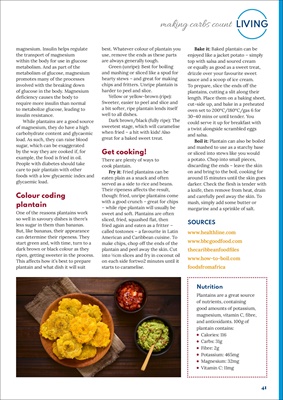
41
LIVING
making carbs count
SOURCES
www.healthline.com
www.bbcgoodfood.com
thecaribbeanfoodfiles
www.how-to-boil.com
foodsfromafrica
Nutrition
Plantains are a great source
of nutrients, containing
good amounts of potassium,
magnesium, vitamin C, fibre,
and antioxidants. 100g of
plantain contains:
Calories: 116
Carbs: 31g
Fibre: 2g
Potassium: 465mg
Magnesium: 32mg
Vitamin C: 11mg
magnesium. Insulin helps regulate
the transport of magnesium
within the body for use in glucose
metabolism. And as part of the
metabolism of glucose, magnesium
promotes many of the processes
involved with the breaking down
of glucose in the body. Magnesium
deficiency causes the body to
require more insulin than normal
to metabolize glucose, leading to
insulin resistance.
While plantains are a good source
of magnesium, they do have a high
carbohydrate content and glycaemic
load. As such, they can raise blood
sugar, which can be exaggerated
by the way they are cooked if, for
example, the food is fried in oil.
People with diabetes should take
care to pair plantain with other
foods with a low glycaemic index and
glycaemic load.
Colour coding
plantain
One of the reasons plantains work
so well in savoury dishes is there's
less sugar in them than bananas.
But, like bananas, their appearance
can determine their ripeness. They
start green and, with time, turn to a
dark brown or black colour as they
ripen, getting sweeter in the process.
This affects how it's best to prepare
plantain and what dish it will suit
best. Whatever colour of plantain you
use, remove the ends as these parts
are always generally tough.
Green (unripe): Best for boiling
and mashing or sliced like a spud for
hearty stews - and great for making
chips and fritters. Unripe plantain is
harder to peel and slice.
Yellow or yellow-brown (ripe):
Sweeter, easier to peel and slice and
a bit softer, ripe plantain lends itself
well to all dishes.
Dark brown/black (fully ripe): The
sweetest stage, which will caramelise
when fried - a hit with kids! Also
great for a baked sweet treat.
Get cooking!
There are plenty of ways to
cook plantain.
Fry it: Fried plantains can be
eaten plain as a snack and often
served as a side to rice and beans.
Their ripeness affects the result,
though: fried, unripe plantains come
with a good crunch - great for chips
- while ripe plantain will usually be
sweet and soft. Plantains are often
sliced, fried, squashed flat, then
fried again and eaten as a fritter -
called tostones - a favourite in Latin
American and Caribbean cuisine. To
make chips, chop off the ends of the
plantain and peel away the skin. Cut
into ½cm slices and fry in coconut oil
on each side fortwo2 minutes until it
starts to caramelise.
Bake it: Baked plantain can be
enjoyed like a jacket potato - simply
top with salsa and soured cream
or equally as good as a sweet treat,
drizzle over your favourite sweet
sauce and a scoop of ice cream.
To prepare, slice the ends off the
plantains, cutting a slit along their
length. Place them on a baking sheet,
cut-side up, and bake in a preheated
oven set to 200ºC/180ºC/gas 6 for
30-40 mins or until tender. You
could serve it up for breakfast with
a twist alongside scrambled eggs
and salsa.
Boil it: Plantain can also be boiled
and mashed to use as a starchy base
or sliced into stews like you would
a potato. Chop into small pieces,
discarding the ends - leave the skin
on and bring to the boil, cooking for
around 15 minutes until the skin goes
darker. Check the flesh is tender with
a knife, then remove from heat, drain
and carefully peel away the skin. To
mash, simply add some butter or
margarine and a sprinkle of salt.